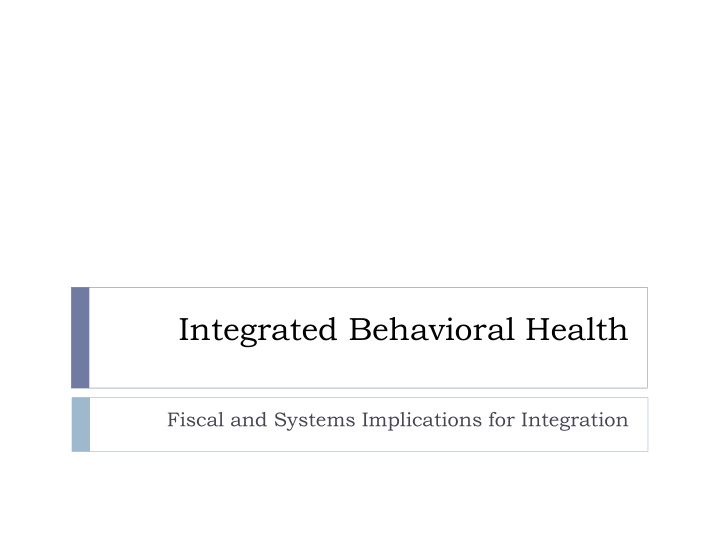



Integrated Behavioral Health Fiscal and Systems Implications for Integration
Integration Process: Formation 3 Inputs Define the Process Delivery System Reform Incentive Pool Plan (DSRIP) 1. Guides the Primary Care-Mental Health Integration Efforts Identifies key Milestones and Expected Outcomes Began FY ‘11, ending FY ’15 Total Value: $35M IMPACT - University of Washington Technical Assistance 2. IMPACT recommended process based on 300+ implementations Interdisciplinary discussion and decision making at 2 levels Local clinic Systems leadership (SCVHC and SCC MHD) MHD - DADS Integration 3.
DSRIP Milestones
IMPACT Technical Assistance DSRIP Planning Yrs 1& 2 Phase 1 Phase 2 T eeny Tiny (TT) T eeny Tiny (TT) Pilot- Pilot- • 2of 6 clinics, (3 rd nearing • 4of 6 clinics start) Staged • EV, SUNNY, Moorpark, DSRIP • Gilroy, Milpitas Alexian Implementation Yrs 3-4 1 st Expansion 1 st Expansion • Double TT Pilot • Double TT Pilot • 2of 6 clinics • 4 of 6 clinics Full Implementation Full Implementation April 2013 *Screen All PC Pts *Screen All PC Pts DSRIP Operation at 2 at 2 of 6 clinics Yrs 3-5 PDSA and DSRIP Evaluation Yrs 3-5
Substance Abuse Integration Jan-May 2012 • Cross Training in SA of MH staff (May 2012) Fall 2012 • Stakeholder Input • Senior Management, (10/12), line staff (11/12), SLC (1/13) 2013-Future • Process TBD • Working towards identifying how SA will be key to IBH
Cost Assessment & Appraisal to Health Plan Yet to be determined Determining Factors: SC VHC senior leadership staff is in transition and short staffed MHD staffing for new division of Behavioral Health/ Cross Systems is currently short dedicated QI Staff and 2.0 FTE key managers to support division director EMR implementation will have significant impact on billings during launch Primary Care (7/2013) and BH (9/2013)have different launch dates making for extended period for billing issues for BH services to be addressed
Anticipated Fiscal Savings Source: University of Washington: AIMS Center, from presentation on 1/24/2012
Evidence The average cost of the IMPACT program was approximately $580 per participant. This is modest compared to the high annual health care costs (approximately $8,000) in this sample of depressed older adults. The cost of providing IMPACT care as a benefit to an insured population of older adults is less than $1.00 per member per month (PMPM). When healthcare costs were examined over a four year period, IMPACT patients had lower average costs for all their medical care – about $3,300 less – than patients receiving usual care, even when the cost of IMPACT care is included. This suggests that an initial investment in better depression care not only improves health, it can actually reduce total health care costs over 4 years (1). Patients with diabetes who received IMPACT care had lower total health care costs than those in usual care, even in a shorter follow-up period (2 years) (2). Lower health care costs in patients who received IMPACT care were also documented by investigators at Kaiser Permanente who tested an adapted version of the program after the original IMPACT trial (3). Read more about Kaiser Permanente's story here. http://impact-uw.org/about/research.html Accessed: 2/5/2013
Enhancement of Care Anticipated Patient Care Enhancements: Access : Increased access to behavioral health services to a population who previously had no access to this care. Training LCSWs will be trained with the needed clinical skills to treat pts within 30 min. follow up appts, and utilize time b/w appts for pts to work towards therapeutic aims and goals LCSWs will be able to teach pts. problem solving skills that they can continue to apply throughout their lives in brief, episodic episodes of care Chronic illness management goals can be woven into BH action plans System redesign LCSWs, PCPs, and Psychiatrists will engage in regular case discussions on most complex/ highest needs pts Registry will build in the trigger to re-evaluate pt treatment plan after 8 weeks, to routinely address those not progressing as expected. Peer Review and Team meetings reinstated EMR: Shared pt charts and tasking facilitating collaborative treatment planning & communication b/w providers Peer partner integration as possible given current staffing levels
Enhancement of Care Anticipated Patient Care Outcomes: IMPACT study results: multiple areas of pt. wellbeing improved after involvement in collaborative care model. 12 months (1 year) post discontinuation of BH services: Chronic illness better managed Depression remained in recovery Physical functioning remained better longer in those who received collaborative care than those who did not Source: University of Washington: AIMS Center, from presentation on 1/24/2012
IMPACT Outcomes SF-12 measures General Health, how Health/ emotional problems/ pain limits daily, work & social activities, Source: University of Washington: AIMS Center, from presentation on 1/24/2012
Enhancement of Care: Case Management Case Management activities of specialty MH is a NON- billable activity for primary care We are in the process of restructuring and redefining the roles of Specialty MH within FQHCs. On occasion, Rehab Counselors have helped transition SMI pts into the lower level of care, coordinating the FQ and BAP. Often, it’s currently more fragmented, and therefore has been less effective coordination and collaboration of care.
Recommend
More recommend